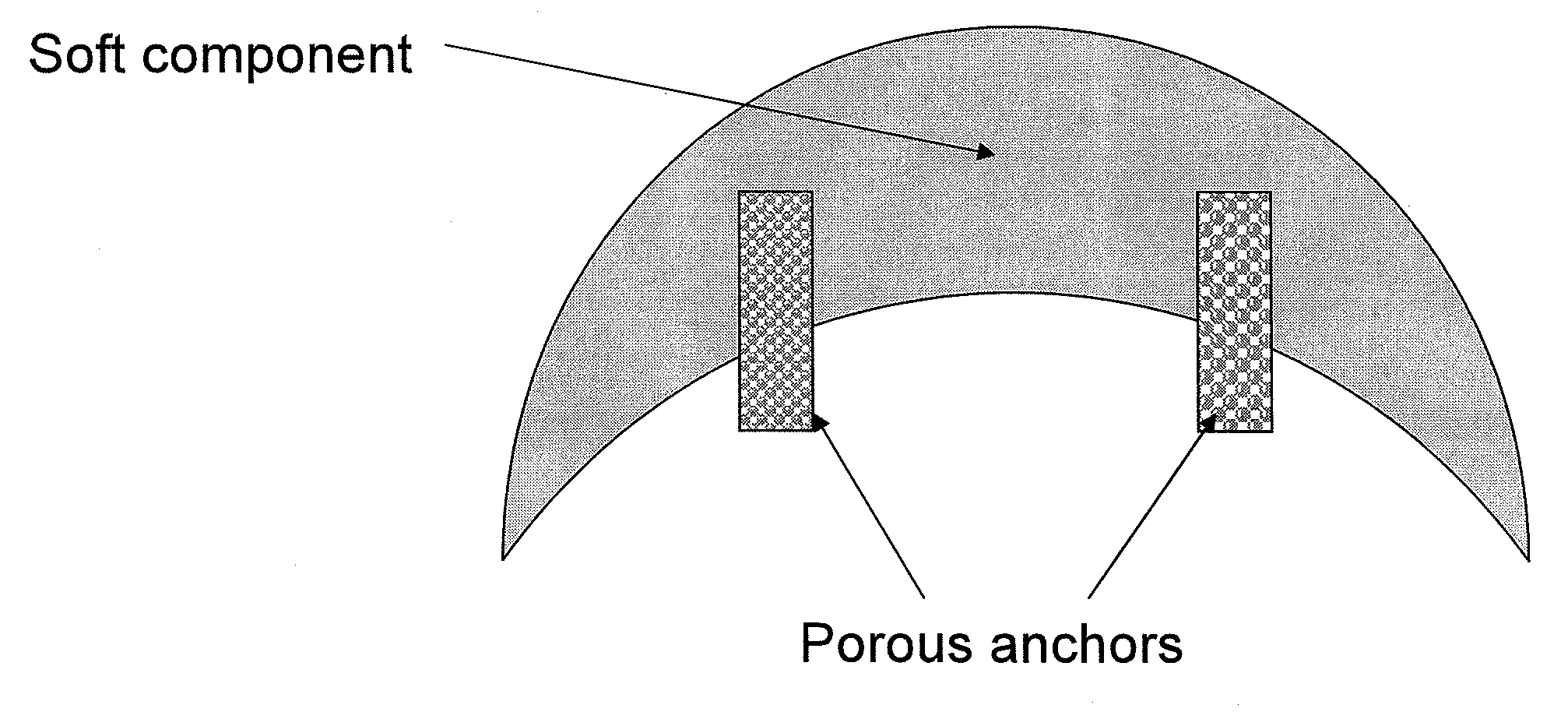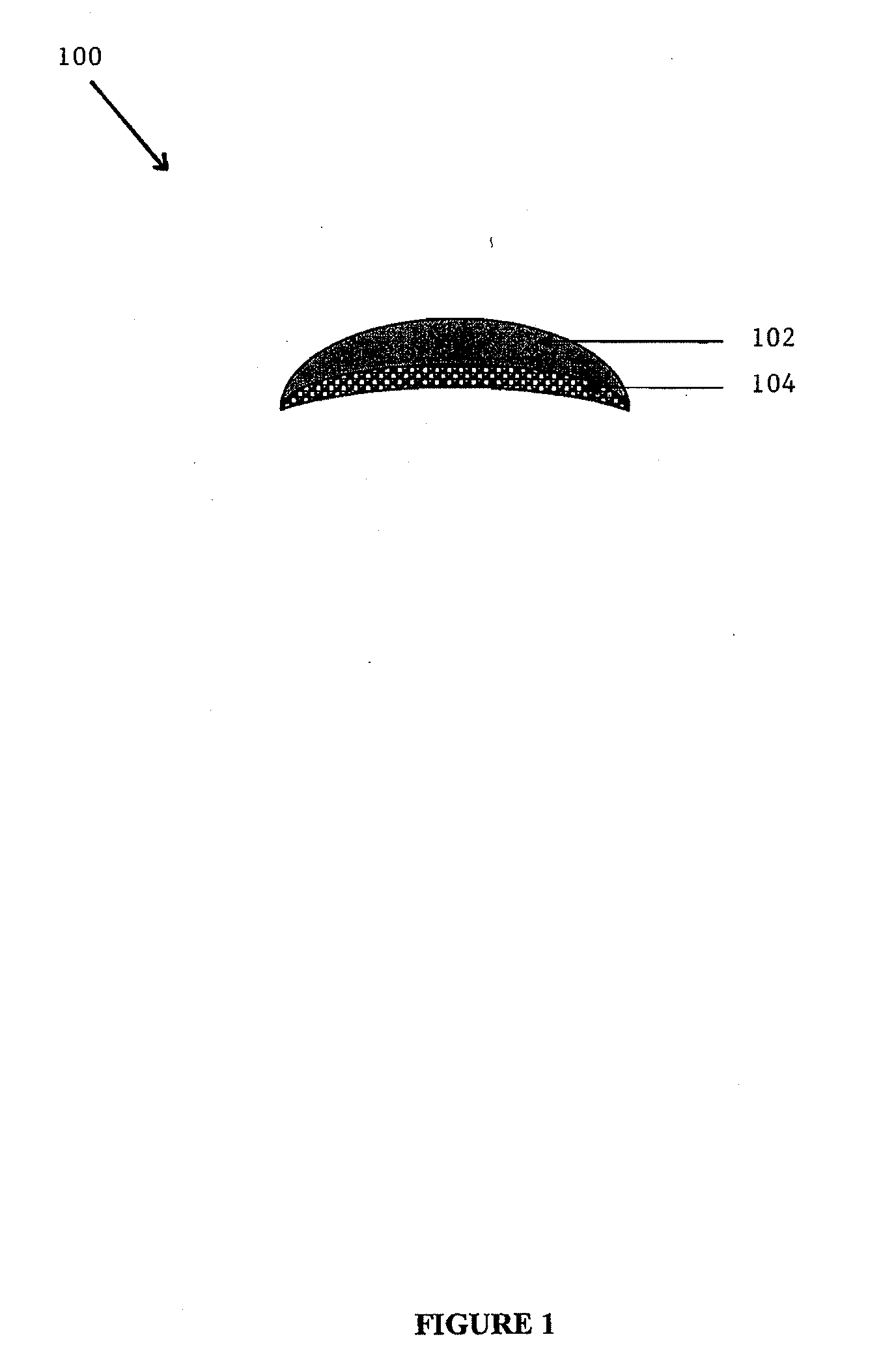Composite Implants and Methods of Making and Using the Same
a composite implant and implant technology, applied in the field of composite implants, can solve the problems of unsatisfactory cosmetic or aesthetic, unfavorable cellular and tissue growth, and unstable implants, and achieve the effects of reducing or eliminating tissue resorption, and reducing or precluding implant motion
- Summary
- Abstract
- Description
- Claims
- Application Information
AI Technical Summary
Benefits of technology
Problems solved by technology
Method used
Image
Examples
example 1
Silicone and MEDPOR® Composite Implant
[0103]A composite implant comprising a soft silicone (polysiloxane) component and a porous HDPE substrate (MEDPOR®) was produced according to the following procedure. MED-4244 was obtained from NuSil Technology of Carpinteria, Calif. Part A and Part B of MED-4244 were mixed in container in a 10:1 ratio of Part A to Part B in accordance with the product instructions. A vacuum was applied to the mixture to remove any air bubbles. 7 grams of the silicone mixture were poured into the cavity of an aluminum chin mold. A MEDPOR® substrate was obtained from Porex Surgical, Inc. of Newnan, Ga. The MEDPOR® substrate displayed a crescent shape with a radius of 35 mm and a uniform thickness of 2 mm. The substrate additionally displayed a length of 65 mm and width of 15 mm in the center, which tapered down to 3 mm on each end. The MEDPOR® substrate had an average pore size greater than about 100 μm and a porosity of about 50%. The MEDPOR® substrate was affix...
example 2
[0105]Poly(vinyl alcohol) (PVA) and MEDPOR® Composite Implant
[0106]A composite implant comprising a soft poly(vinyl alcohol) hydrogel component and a porous HDPE substrate (MEDPOR®) was produced according to the following procedure. Poly(vinyl alcohol) powder was mixed with water in a ratio of 20 parts powder to 80 parts water. The resulting mixture was placed in an oven at 105° C. for 16 hours. The poly(vinyl alcohol) / water mixture was removed from the oven, and 8 g of the mixture was poured into the cavity of an aluminum chin mold.
[0107]A MEDPOR® substrate was obtained from Porex Surgical, Inc. of Newnan, Ga. The MEDPOR® substrate displayed a crescent shape with a radius of 35 mm and a uniform thickness of 2 mm. The substrate additionally displayed a length of 65 mm and width of 15 mm in the center, which tapered down to 3 mm on each end. The MEDPOR® substrate had an average pore size greater than about 100 μm and a porosity of about 50%. The MEDPOR® substrate was affixed to the c...
example 3
Silicone and MEDPOR® Composite Implant for a Chin
[0109]A composite implant comprising a soft silicone (polysiloxane) component and a porous HDPE substrate was produced according to the following procedure. MED-4244 was obtained from NuSil Technology of Carpinteria, Calif. Part A and Part B of MED-4244 were mixed in container in a 10:1 ratio of Part A to Part B in accordance with the product instructions. A vacuum was applied to the mixture to remove any air bubbles. 7 grams of the silicone mixture were poured into the cavity of an aluminum chin mold. The mold was subsequently placed in a hot press at 177° C. for five minutes to cure the silicon mixture. The mold was removed from the oven and allowed to cool to room temperature. The mold was disassembled, and a soft silicone component was removed and was later cured at 150° C. for about 1 hour in an oven for a completed cure.
[0110]A MEDPOR® substrate was obtained from Porex Surgical, Inc. of Newnan, Ga. The MEDPOR® substrate displaye...
PUM
| Property | Measurement | Unit |
|---|---|---|
| porosity | aaaaa | aaaaa |
| pore size | aaaaa | aaaaa |
| thickness | aaaaa | aaaaa |
Abstract
Description
Claims
Application Information
 Login to View More
Login to View More - R&D
- Intellectual Property
- Life Sciences
- Materials
- Tech Scout
- Unparalleled Data Quality
- Higher Quality Content
- 60% Fewer Hallucinations
Browse by: Latest US Patents, China's latest patents, Technical Efficacy Thesaurus, Application Domain, Technology Topic, Popular Technical Reports.
© 2025 PatSnap. All rights reserved.Legal|Privacy policy|Modern Slavery Act Transparency Statement|Sitemap|About US| Contact US: help@patsnap.com



